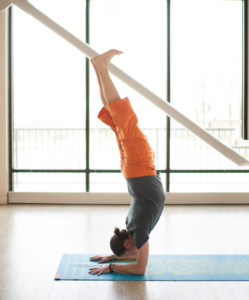 How do you carve a path into the unknown?
How do you carve a path into the unknown?
Stepping into the unknown—whether it’s a new pose or a new stage in our lives—is a challenge precisely because there are no handrails, guidelines, or previously trampled paths to point the way. You have to carve your own path.
The first time that I left my hospital bed after surgery, I realized how much my yoga practice helps me learn how to find a path where none exists.
That morning it felt like I’d never stepped out of bed before. But, turning mindfully to drop my legs over the edge of the bed, I realized that I was doing a twist and could turn without discomfort because I knew the principles of doing a twist thanks to my yoga practice.
And standing for the first time I found my balance thanks to the principles of balance that I’d learned in Tree Pose.
How Yoga Teaches Us About the Unknown
Our life, whether we’re healthy or recovering from surgery, gives us a chance to practice yoga every moment, and our yoga practice can help us step into the unknown poses of our life if we remember the principles that we learn on our mats.
It’s easy to forget that once poses like Tree Pose, Easy Dancer, or Handstand were poses that I’d never done before.
How did I step into the unknown of Handstand, a pose that looked so far beyond my ability that I never thought I’d be able to balance upside down on my hands at all?
I used what I knew to move into an unfamiliar space. I knew how to set my hands shoulder-width apart because I’d learned how to do so in Downward Dog (which is, in many ways, a prelude to Handstand).
And then it was a matter of learning how to kick my legs over my head. I couldn’t kick up all at once, but I could kick up a few feet off the mat with each attempt, barely able to stay aloft for more than a second or two. The more I practiced what I knew, the longer I was able to stay aloft.
I learned to do what my teacher, Jaye, calls “hang time.” From Downward Dog, I kicked one leg up into the air so that I could “hang” in the air a moment with both feet off the ground, kicking with each effort closer and closer to the vertical position required for the pose.
With each kick, I learned how to “hang” in the air a little longer and increased the strength in my shoulders. I learned how it felt to move toward the vertical line of handstand with both legs in the air at once. And eventually, using the wall for support, I was able to kick my legs over my head and balance upside down.
From there—from a place that had been unknown but to which I’d carved a path—I was able to gingerly push off the wall with my toes and stand on my hands without using any props. It may have only been a fraction of a second that first time, but I was doing a handstand. I had carved my own path into the unknown.
Carving a path into the unknown is like building a bridge over a wide river.
Whether you’re trying to learn something new (like handstands or dancing or sailing), or going into a challenging place (like the operating room for surgery or to give a speech to a group of strangers), you can apply the same principles that you use on the mat to step into the unknown.
You build on what you know and, once you feel secure in your foundation, you extend yourself over the river, adding to what you know bit by bit, until you reach the other side.
Journal Practice: Notice the next time that you step into a new pose on your mat. How do you learn how to carve a path into the unknown? How do you find your way? And then, off the mat, notice how you step into a new pose in your life—a new job, a new relationship, or something that you’ve never done before? How is it similar to learning a new yoga pose? Write: 10 min.
